Emergency Nursing Case Scenario: Assessment and Management Report
VerifiedAdded on 2022/09/07
|6
|1589
|13
Report
AI Summary
This report presents a comprehensive analysis of an emergency nursing case scenario, focusing on the assessment and management of a patient presenting to the emergency department. The report begins by identifying the appropriate Australasian Triage Scale (ATS) category for the patient and justifying the rationale behind the assignment. It then outlines the location within the emergency department suitable for assessment and treatment. The report further explores the need for a secondary survey and ECG, providing rationales for each. ECG findings, including heart rate and rhythm, are analyzed. The report then delves into focused assessments, identifying relevant body systems and justifying the assessment choices. The report also examines prescribed medications, including paracetamol, ketorolac, morphine, and Penthrox inhaler, and their effectiveness in managing the patient's condition. Finally, the report evaluates the patient's potential dissatisfaction with care, and the importance of regular monitoring of vital signs to prevent complications. The report uses current research to support its findings and recommendations.
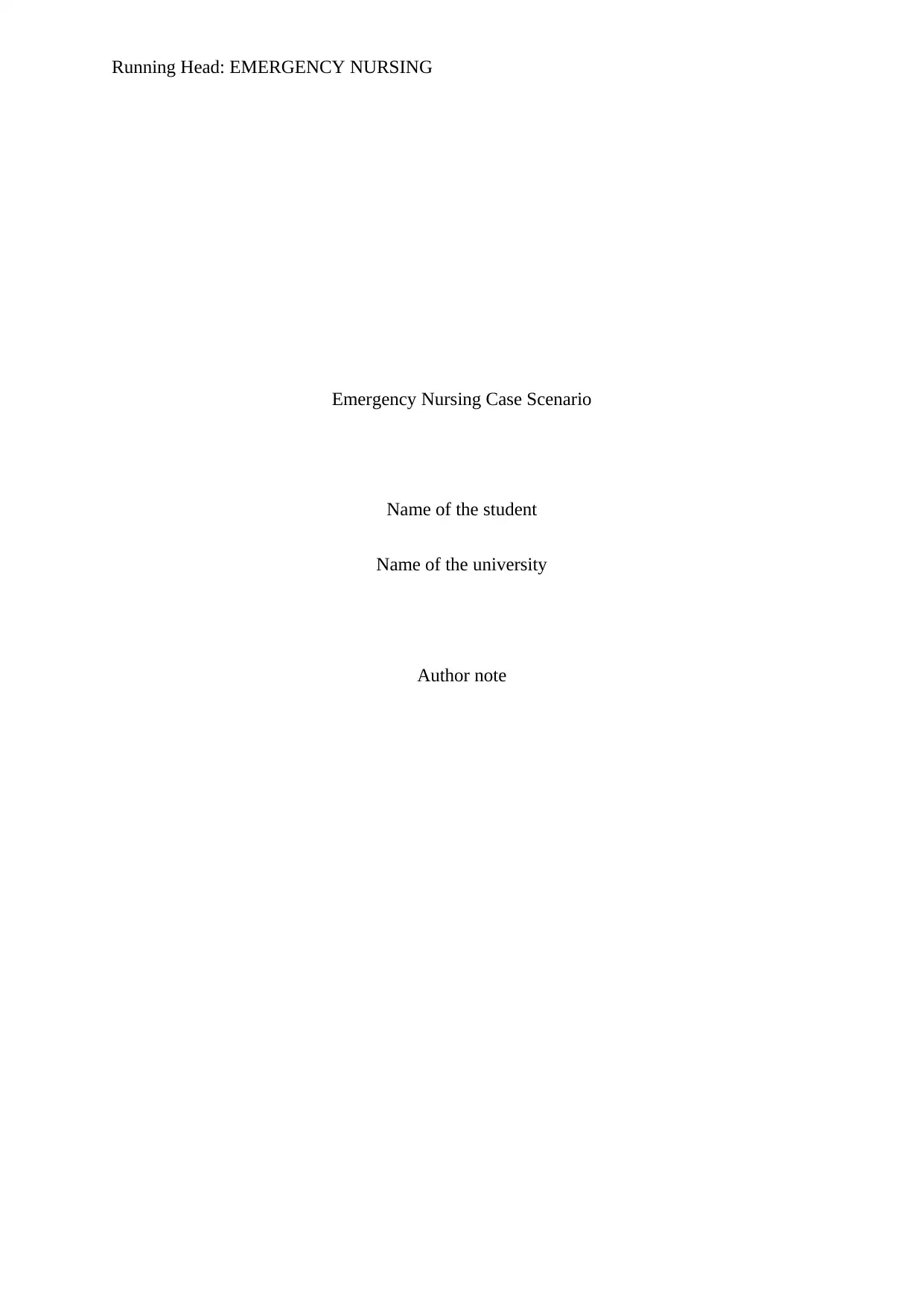
Running Head: EMERGENCY NURSING
Emergency Nursing Case Scenario
Name of the student
Name of the university
Author note
Emergency Nursing Case Scenario
Name of the student
Name of the university
Author note
Paraphrase This Document
Need a fresh take? Get an instant paraphrase of this document with our AI Paraphraser
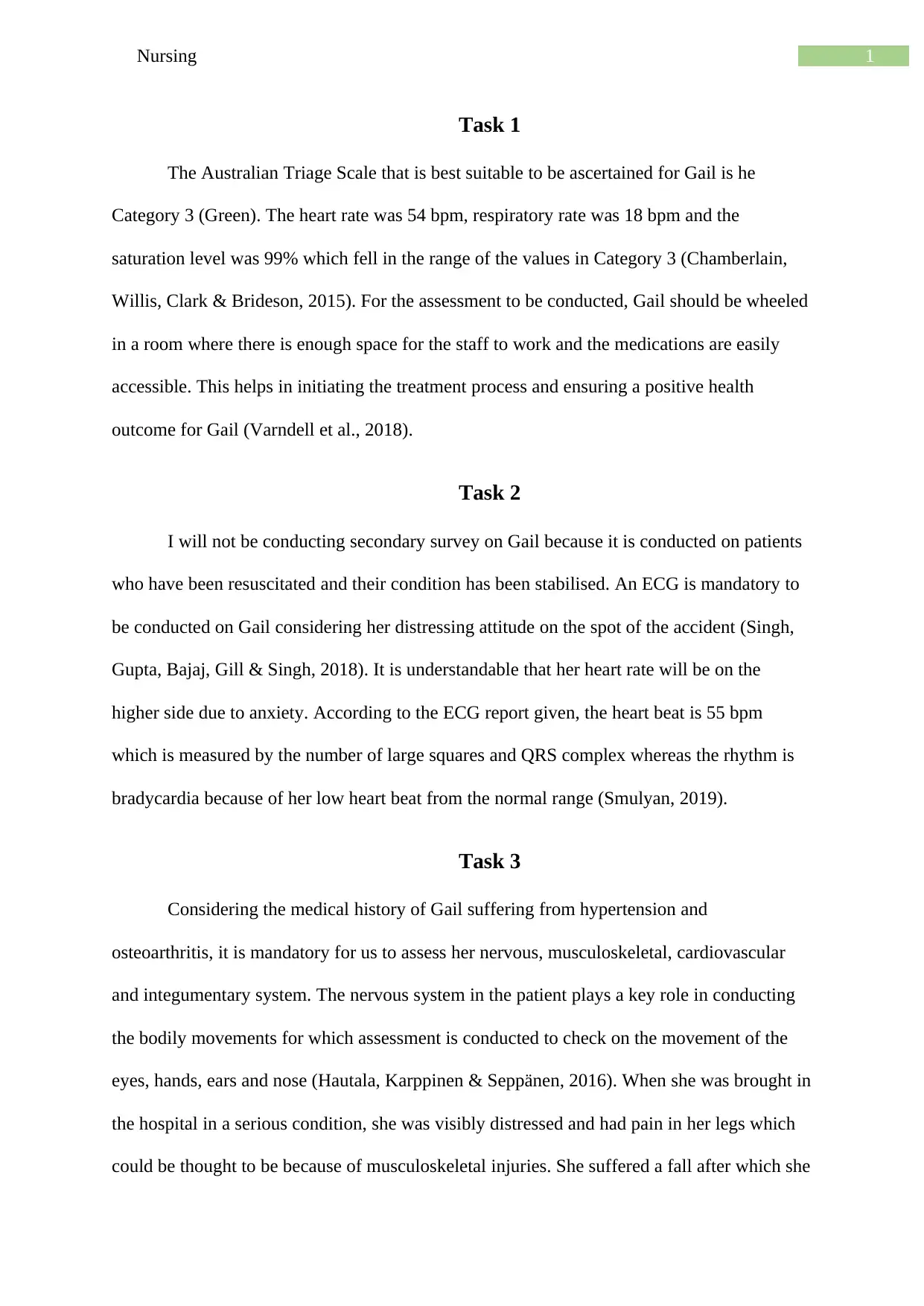
1Nursing
Task 1
The Australian Triage Scale that is best suitable to be ascertained for Gail is he
Category 3 (Green). The heart rate was 54 bpm, respiratory rate was 18 bpm and the
saturation level was 99% which fell in the range of the values in Category 3 (Chamberlain,
Willis, Clark & Brideson, 2015). For the assessment to be conducted, Gail should be wheeled
in a room where there is enough space for the staff to work and the medications are easily
accessible. This helps in initiating the treatment process and ensuring a positive health
outcome for Gail (Varndell et al., 2018).
Task 2
I will not be conducting secondary survey on Gail because it is conducted on patients
who have been resuscitated and their condition has been stabilised. An ECG is mandatory to
be conducted on Gail considering her distressing attitude on the spot of the accident (Singh,
Gupta, Bajaj, Gill & Singh, 2018). It is understandable that her heart rate will be on the
higher side due to anxiety. According to the ECG report given, the heart beat is 55 bpm
which is measured by the number of large squares and QRS complex whereas the rhythm is
bradycardia because of her low heart beat from the normal range (Smulyan, 2019).
Task 3
Considering the medical history of Gail suffering from hypertension and
osteoarthritis, it is mandatory for us to assess her nervous, musculoskeletal, cardiovascular
and integumentary system. The nervous system in the patient plays a key role in conducting
the bodily movements for which assessment is conducted to check on the movement of the
eyes, hands, ears and nose (Hautala, Karppinen & Seppänen, 2016). When she was brought in
the hospital in a serious condition, she was visibly distressed and had pain in her legs which
could be thought to be because of musculoskeletal injuries. She suffered a fall after which she
Task 1
The Australian Triage Scale that is best suitable to be ascertained for Gail is he
Category 3 (Green). The heart rate was 54 bpm, respiratory rate was 18 bpm and the
saturation level was 99% which fell in the range of the values in Category 3 (Chamberlain,
Willis, Clark & Brideson, 2015). For the assessment to be conducted, Gail should be wheeled
in a room where there is enough space for the staff to work and the medications are easily
accessible. This helps in initiating the treatment process and ensuring a positive health
outcome for Gail (Varndell et al., 2018).
Task 2
I will not be conducting secondary survey on Gail because it is conducted on patients
who have been resuscitated and their condition has been stabilised. An ECG is mandatory to
be conducted on Gail considering her distressing attitude on the spot of the accident (Singh,
Gupta, Bajaj, Gill & Singh, 2018). It is understandable that her heart rate will be on the
higher side due to anxiety. According to the ECG report given, the heart beat is 55 bpm
which is measured by the number of large squares and QRS complex whereas the rhythm is
bradycardia because of her low heart beat from the normal range (Smulyan, 2019).
Task 3
Considering the medical history of Gail suffering from hypertension and
osteoarthritis, it is mandatory for us to assess her nervous, musculoskeletal, cardiovascular
and integumentary system. The nervous system in the patient plays a key role in conducting
the bodily movements for which assessment is conducted to check on the movement of the
eyes, hands, ears and nose (Hautala, Karppinen & Seppänen, 2016). When she was brought in
the hospital in a serious condition, she was visibly distressed and had pain in her legs which
could be thought to be because of musculoskeletal injuries. She suffered a fall after which she
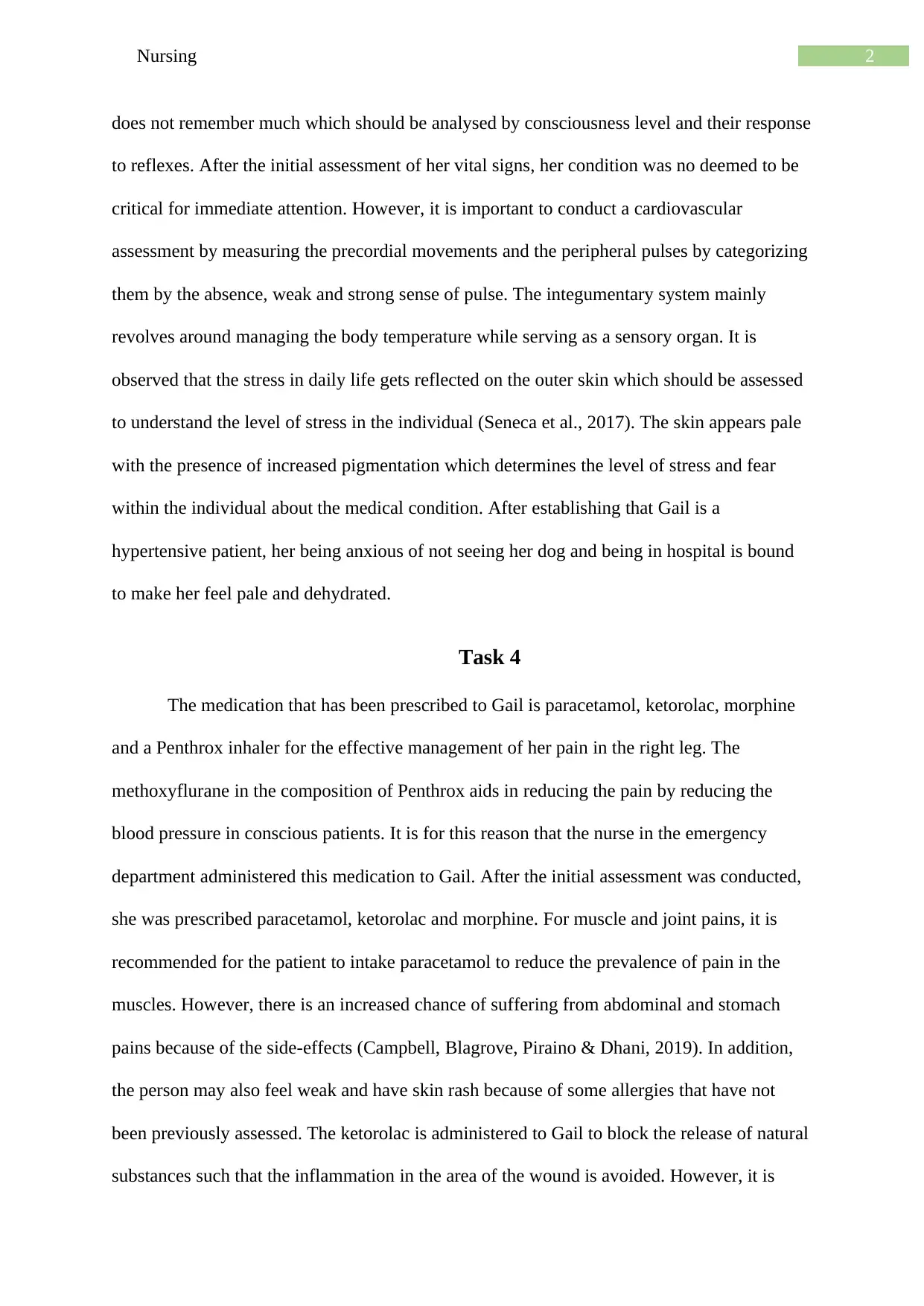
2Nursing
does not remember much which should be analysed by consciousness level and their response
to reflexes. After the initial assessment of her vital signs, her condition was no deemed to be
critical for immediate attention. However, it is important to conduct a cardiovascular
assessment by measuring the precordial movements and the peripheral pulses by categorizing
them by the absence, weak and strong sense of pulse. The integumentary system mainly
revolves around managing the body temperature while serving as a sensory organ. It is
observed that the stress in daily life gets reflected on the outer skin which should be assessed
to understand the level of stress in the individual (Seneca et al., 2017). The skin appears pale
with the presence of increased pigmentation which determines the level of stress and fear
within the individual about the medical condition. After establishing that Gail is a
hypertensive patient, her being anxious of not seeing her dog and being in hospital is bound
to make her feel pale and dehydrated.
Task 4
The medication that has been prescribed to Gail is paracetamol, ketorolac, morphine
and a Penthrox inhaler for the effective management of her pain in the right leg. The
methoxyflurane in the composition of Penthrox aids in reducing the pain by reducing the
blood pressure in conscious patients. It is for this reason that the nurse in the emergency
department administered this medication to Gail. After the initial assessment was conducted,
she was prescribed paracetamol, ketorolac and morphine. For muscle and joint pains, it is
recommended for the patient to intake paracetamol to reduce the prevalence of pain in the
muscles. However, there is an increased chance of suffering from abdominal and stomach
pains because of the side-effects (Campbell, Blagrove, Piraino & Dhani, 2019). In addition,
the person may also feel weak and have skin rash because of some allergies that have not
been previously assessed. The ketorolac is administered to Gail to block the release of natural
substances such that the inflammation in the area of the wound is avoided. However, it is
does not remember much which should be analysed by consciousness level and their response
to reflexes. After the initial assessment of her vital signs, her condition was no deemed to be
critical for immediate attention. However, it is important to conduct a cardiovascular
assessment by measuring the precordial movements and the peripheral pulses by categorizing
them by the absence, weak and strong sense of pulse. The integumentary system mainly
revolves around managing the body temperature while serving as a sensory organ. It is
observed that the stress in daily life gets reflected on the outer skin which should be assessed
to understand the level of stress in the individual (Seneca et al., 2017). The skin appears pale
with the presence of increased pigmentation which determines the level of stress and fear
within the individual about the medical condition. After establishing that Gail is a
hypertensive patient, her being anxious of not seeing her dog and being in hospital is bound
to make her feel pale and dehydrated.
Task 4
The medication that has been prescribed to Gail is paracetamol, ketorolac, morphine
and a Penthrox inhaler for the effective management of her pain in the right leg. The
methoxyflurane in the composition of Penthrox aids in reducing the pain by reducing the
blood pressure in conscious patients. It is for this reason that the nurse in the emergency
department administered this medication to Gail. After the initial assessment was conducted,
she was prescribed paracetamol, ketorolac and morphine. For muscle and joint pains, it is
recommended for the patient to intake paracetamol to reduce the prevalence of pain in the
muscles. However, there is an increased chance of suffering from abdominal and stomach
pains because of the side-effects (Campbell, Blagrove, Piraino & Dhani, 2019). In addition,
the person may also feel weak and have skin rash because of some allergies that have not
been previously assessed. The ketorolac is administered to Gail to block the release of natural
substances such that the inflammation in the area of the wound is avoided. However, it is
⊘ This is a preview!⊘
Do you want full access?
Subscribe today to unlock all pages.

Trusted by 1+ million students worldwide
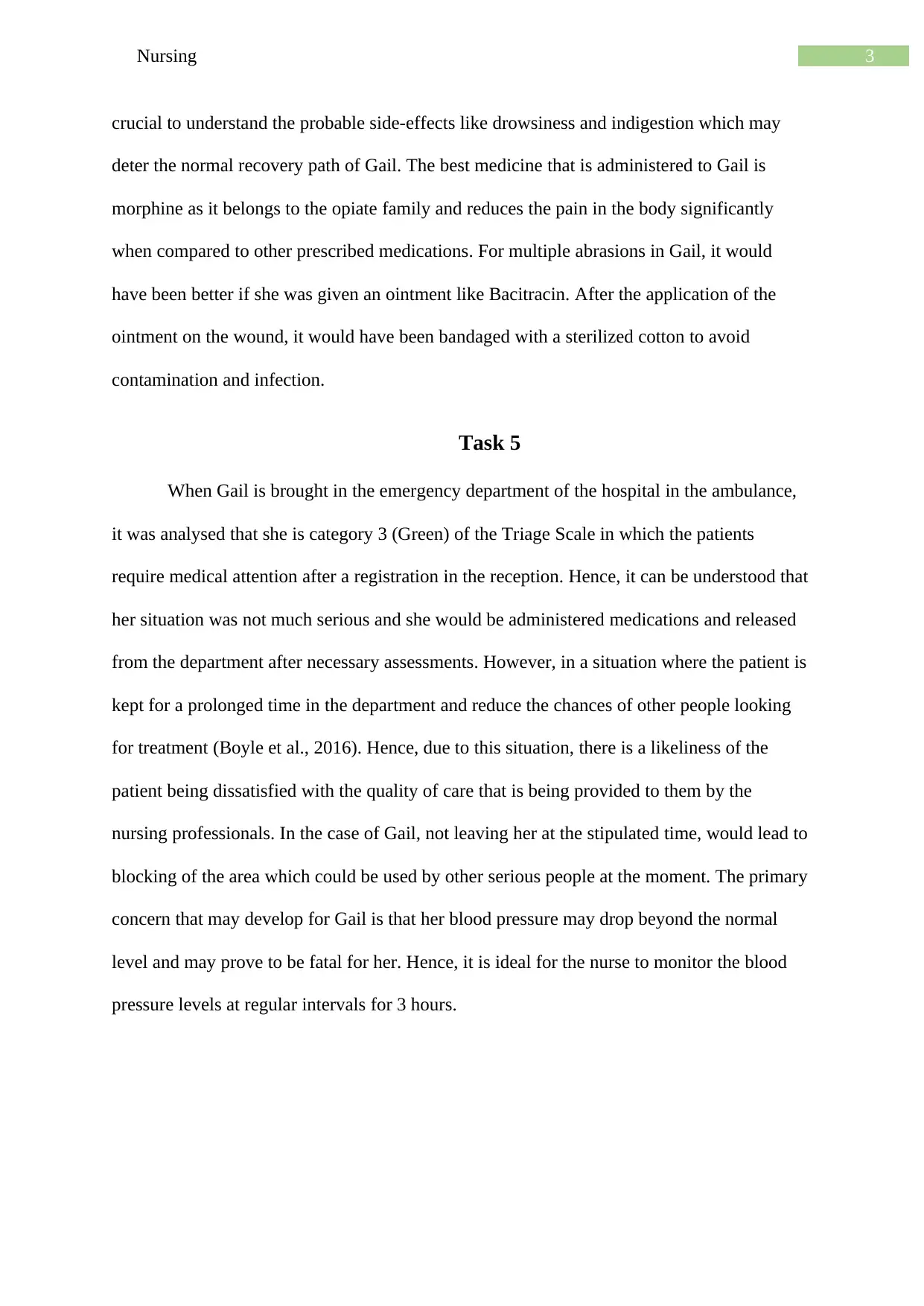
3Nursing
crucial to understand the probable side-effects like drowsiness and indigestion which may
deter the normal recovery path of Gail. The best medicine that is administered to Gail is
morphine as it belongs to the opiate family and reduces the pain in the body significantly
when compared to other prescribed medications. For multiple abrasions in Gail, it would
have been better if she was given an ointment like Bacitracin. After the application of the
ointment on the wound, it would have been bandaged with a sterilized cotton to avoid
contamination and infection.
Task 5
When Gail is brought in the emergency department of the hospital in the ambulance,
it was analysed that she is category 3 (Green) of the Triage Scale in which the patients
require medical attention after a registration in the reception. Hence, it can be understood that
her situation was not much serious and she would be administered medications and released
from the department after necessary assessments. However, in a situation where the patient is
kept for a prolonged time in the department and reduce the chances of other people looking
for treatment (Boyle et al., 2016). Hence, due to this situation, there is a likeliness of the
patient being dissatisfied with the quality of care that is being provided to them by the
nursing professionals. In the case of Gail, not leaving her at the stipulated time, would lead to
blocking of the area which could be used by other serious people at the moment. The primary
concern that may develop for Gail is that her blood pressure may drop beyond the normal
level and may prove to be fatal for her. Hence, it is ideal for the nurse to monitor the blood
pressure levels at regular intervals for 3 hours.
crucial to understand the probable side-effects like drowsiness and indigestion which may
deter the normal recovery path of Gail. The best medicine that is administered to Gail is
morphine as it belongs to the opiate family and reduces the pain in the body significantly
when compared to other prescribed medications. For multiple abrasions in Gail, it would
have been better if she was given an ointment like Bacitracin. After the application of the
ointment on the wound, it would have been bandaged with a sterilized cotton to avoid
contamination and infection.
Task 5
When Gail is brought in the emergency department of the hospital in the ambulance,
it was analysed that she is category 3 (Green) of the Triage Scale in which the patients
require medical attention after a registration in the reception. Hence, it can be understood that
her situation was not much serious and she would be administered medications and released
from the department after necessary assessments. However, in a situation where the patient is
kept for a prolonged time in the department and reduce the chances of other people looking
for treatment (Boyle et al., 2016). Hence, due to this situation, there is a likeliness of the
patient being dissatisfied with the quality of care that is being provided to them by the
nursing professionals. In the case of Gail, not leaving her at the stipulated time, would lead to
blocking of the area which could be used by other serious people at the moment. The primary
concern that may develop for Gail is that her blood pressure may drop beyond the normal
level and may prove to be fatal for her. Hence, it is ideal for the nurse to monitor the blood
pressure levels at regular intervals for 3 hours.
Paraphrase This Document
Need a fresh take? Get an instant paraphrase of this document with our AI Paraphraser
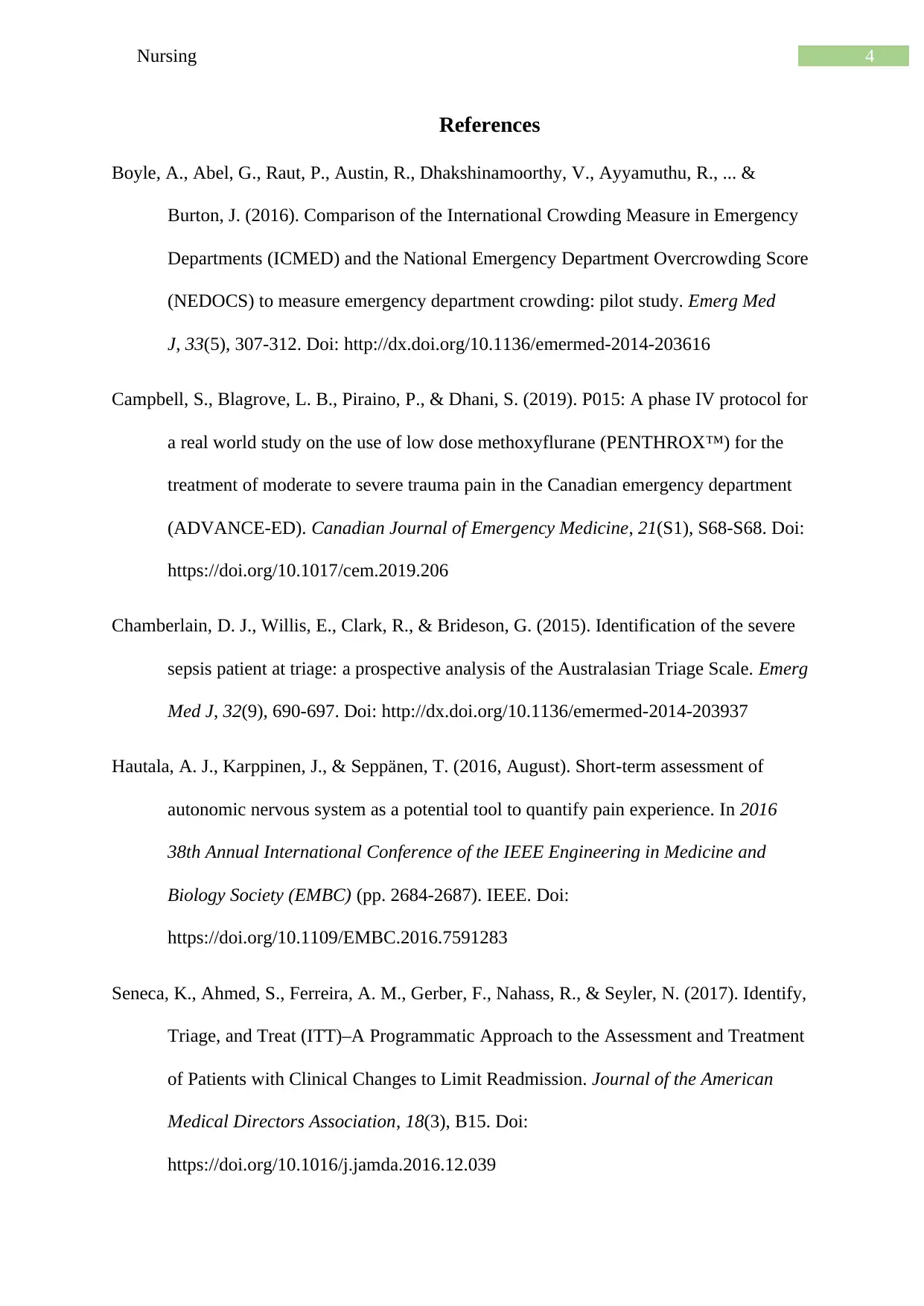
4Nursing
References
Boyle, A., Abel, G., Raut, P., Austin, R., Dhakshinamoorthy, V., Ayyamuthu, R., ... &
Burton, J. (2016). Comparison of the International Crowding Measure in Emergency
Departments (ICMED) and the National Emergency Department Overcrowding Score
(NEDOCS) to measure emergency department crowding: pilot study. Emerg Med
J, 33(5), 307-312. Doi: http://dx.doi.org/10.1136/emermed-2014-203616
Campbell, S., Blagrove, L. B., Piraino, P., & Dhani, S. (2019). P015: A phase IV protocol for
a real world study on the use of low dose methoxyflurane (PENTHROX™) for the
treatment of moderate to severe trauma pain in the Canadian emergency department
(ADVANCE-ED). Canadian Journal of Emergency Medicine, 21(S1), S68-S68. Doi:
https://doi.org/10.1017/cem.2019.206
Chamberlain, D. J., Willis, E., Clark, R., & Brideson, G. (2015). Identification of the severe
sepsis patient at triage: a prospective analysis of the Australasian Triage Scale. Emerg
Med J, 32(9), 690-697. Doi: http://dx.doi.org/10.1136/emermed-2014-203937
Hautala, A. J., Karppinen, J., & Seppänen, T. (2016, August). Short-term assessment of
autonomic nervous system as a potential tool to quantify pain experience. In 2016
38th Annual International Conference of the IEEE Engineering in Medicine and
Biology Society (EMBC) (pp. 2684-2687). IEEE. Doi:
https://doi.org/10.1109/EMBC.2016.7591283
Seneca, K., Ahmed, S., Ferreira, A. M., Gerber, F., Nahass, R., & Seyler, N. (2017). Identify,
Triage, and Treat (ITT)–A Programmatic Approach to the Assessment and Treatment
of Patients with Clinical Changes to Limit Readmission. Journal of the American
Medical Directors Association, 18(3), B15. Doi:
https://doi.org/10.1016/j.jamda.2016.12.039
References
Boyle, A., Abel, G., Raut, P., Austin, R., Dhakshinamoorthy, V., Ayyamuthu, R., ... &
Burton, J. (2016). Comparison of the International Crowding Measure in Emergency
Departments (ICMED) and the National Emergency Department Overcrowding Score
(NEDOCS) to measure emergency department crowding: pilot study. Emerg Med
J, 33(5), 307-312. Doi: http://dx.doi.org/10.1136/emermed-2014-203616
Campbell, S., Blagrove, L. B., Piraino, P., & Dhani, S. (2019). P015: A phase IV protocol for
a real world study on the use of low dose methoxyflurane (PENTHROX™) for the
treatment of moderate to severe trauma pain in the Canadian emergency department
(ADVANCE-ED). Canadian Journal of Emergency Medicine, 21(S1), S68-S68. Doi:
https://doi.org/10.1017/cem.2019.206
Chamberlain, D. J., Willis, E., Clark, R., & Brideson, G. (2015). Identification of the severe
sepsis patient at triage: a prospective analysis of the Australasian Triage Scale. Emerg
Med J, 32(9), 690-697. Doi: http://dx.doi.org/10.1136/emermed-2014-203937
Hautala, A. J., Karppinen, J., & Seppänen, T. (2016, August). Short-term assessment of
autonomic nervous system as a potential tool to quantify pain experience. In 2016
38th Annual International Conference of the IEEE Engineering in Medicine and
Biology Society (EMBC) (pp. 2684-2687). IEEE. Doi:
https://doi.org/10.1109/EMBC.2016.7591283
Seneca, K., Ahmed, S., Ferreira, A. M., Gerber, F., Nahass, R., & Seyler, N. (2017). Identify,
Triage, and Treat (ITT)–A Programmatic Approach to the Assessment and Treatment
of Patients with Clinical Changes to Limit Readmission. Journal of the American
Medical Directors Association, 18(3), B15. Doi:
https://doi.org/10.1016/j.jamda.2016.12.039
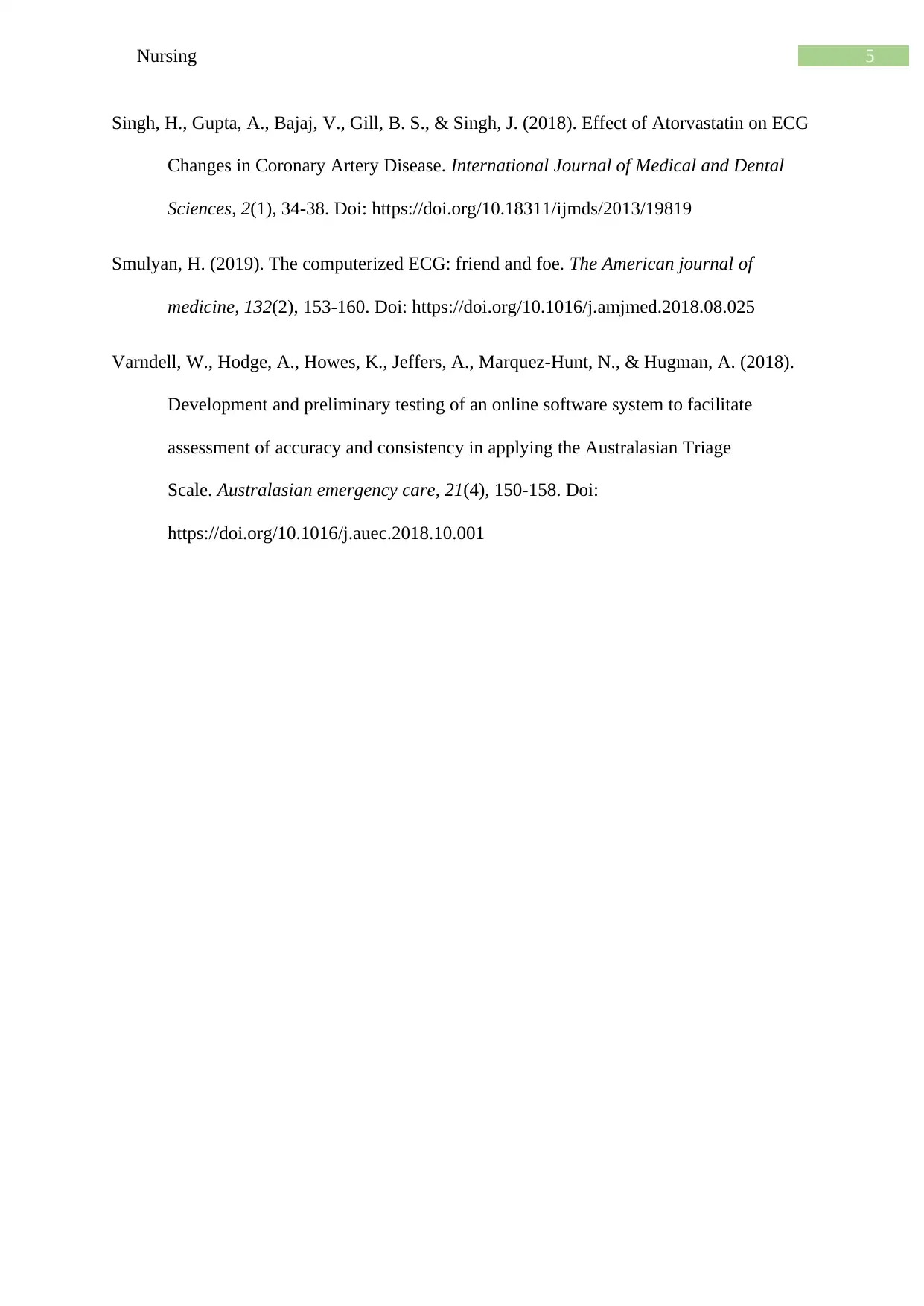
5Nursing
Singh, H., Gupta, A., Bajaj, V., Gill, B. S., & Singh, J. (2018). Effect of Atorvastatin on ECG
Changes in Coronary Artery Disease. International Journal of Medical and Dental
Sciences, 2(1), 34-38. Doi: https://doi.org/10.18311/ijmds/2013/19819
Smulyan, H. (2019). The computerized ECG: friend and foe. The American journal of
medicine, 132(2), 153-160. Doi: https://doi.org/10.1016/j.amjmed.2018.08.025
Varndell, W., Hodge, A., Howes, K., Jeffers, A., Marquez-Hunt, N., & Hugman, A. (2018).
Development and preliminary testing of an online software system to facilitate
assessment of accuracy and consistency in applying the Australasian Triage
Scale. Australasian emergency care, 21(4), 150-158. Doi:
https://doi.org/10.1016/j.auec.2018.10.001
Singh, H., Gupta, A., Bajaj, V., Gill, B. S., & Singh, J. (2018). Effect of Atorvastatin on ECG
Changes in Coronary Artery Disease. International Journal of Medical and Dental
Sciences, 2(1), 34-38. Doi: https://doi.org/10.18311/ijmds/2013/19819
Smulyan, H. (2019). The computerized ECG: friend and foe. The American journal of
medicine, 132(2), 153-160. Doi: https://doi.org/10.1016/j.amjmed.2018.08.025
Varndell, W., Hodge, A., Howes, K., Jeffers, A., Marquez-Hunt, N., & Hugman, A. (2018).
Development and preliminary testing of an online software system to facilitate
assessment of accuracy and consistency in applying the Australasian Triage
Scale. Australasian emergency care, 21(4), 150-158. Doi:
https://doi.org/10.1016/j.auec.2018.10.001
⊘ This is a preview!⊘
Do you want full access?
Subscribe today to unlock all pages.

Trusted by 1+ million students worldwide
1 out of 6
Related Documents
Your All-in-One AI-Powered Toolkit for Academic Success.
+13062052269
info@desklib.com
Available 24*7 on WhatsApp / Email
![[object Object]](/_next/static/media/star-bottom.7253800d.svg)
Unlock your academic potential
Copyright © 2020–2025 A2Z Services. All Rights Reserved. Developed and managed by ZUCOL.





